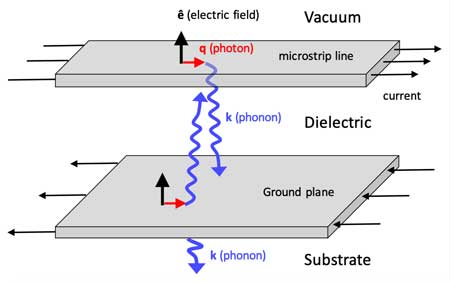| Nov 18, 2020 | |
Piezoelectric energy absorption in quantum interfaces |
|
| (Nanowerk Spotlight) Researchers at the University of Victoria have developed a theory of piezoelectrics with the goal to increase coherence times in quantum computers. | |
| A new paper in Physical Review Letters ("Intrinsic Photon Loss at the Interface of Superconducting Devices") elucidates the mechanism of energy absorption taking place in quantum computers, and recommends optimal materials for these devices. Professor de Sousa, who published this paper with former postdoctoral fellow Igor Diniz (now a professor in Brazil), spoke with Nanowerk about their findings. | |
| Quantum computing remains a major focal point of research globally, though which problem it will develop an advantage over remains to be seen. Quantum advantage has yet to be achieved, partially due to the short coherence times of qubits. Coherence refers to the synchronization of quantum waves, which are required in order for qubits to function. Coherence times continue to improve, but remain insufficient for large-scale quantum computing. | |
| Quantum computers are currently limited by energy absorption occurring at rough surfaces and interfaces, which are full of defects. As energy is absorbed, the photons carrying quantum information are lost into heat, and the qubits lose their coherence. There are many efforts underway to increase the material quality for quantum computers, so that energy relaxation and noise can be avoided. | |
| Previously, theorists believed that there would be negligible energy absorption from perfect materials, consisting of crystalline surfaces and interfaces. In order to avoid the energy loss, the reasoning went, perfectly crystalline materials were required. The new theory shows that all materials undergo energy absorption in relative degrees, regardless of their perfection. This happens because all interfaces are necessarily piezoelectric, even when they are made of materials that are non-piezoelectric in bulk form. | |
 |
|
| Photon loss at the interface due to the piezoelectric effect. (Image courtesy of the researchers) | |
| The piezoelectric effect converts electrical energy into mechanical vibrations. In the case of quantum devices, the photons making up the electrical energy are converted into phonons, the lattice vibrations that carry heat away in a material. This process limits the coherence time of quantum computers made with solid state devices. | |
| The new theory predicts qubit coherence times that are over 100 times greater than the current state of the art. This shows that material improvements can go a long way towards improving the quality of quantum computing devices, bringing quantum advantage one step closer. | |
| Professor de Sousa recommends that to minimize the piezoelectric energy absorption “quantum devices should have wires made out of aluminum, on top of a sapphire substrate”. He recommends sapphire capping on the wires but says “it will take progress in device engineering to achieve this. Our job as theorists was to compute the amount of loss at each interface so that people would know what the implications of their choices are”. | |
| A Nanowerk exclusive by Jack Seaberry. Jack is a technical writer from the University of Victoria. | |
|
Become a Spotlight guest author! Join our large and growing group of guest contributors. Have you just published a scientific paper or have other exciting developments to share with the nanotechnology community? Here is how to publish on nanowerk.com. |
|
